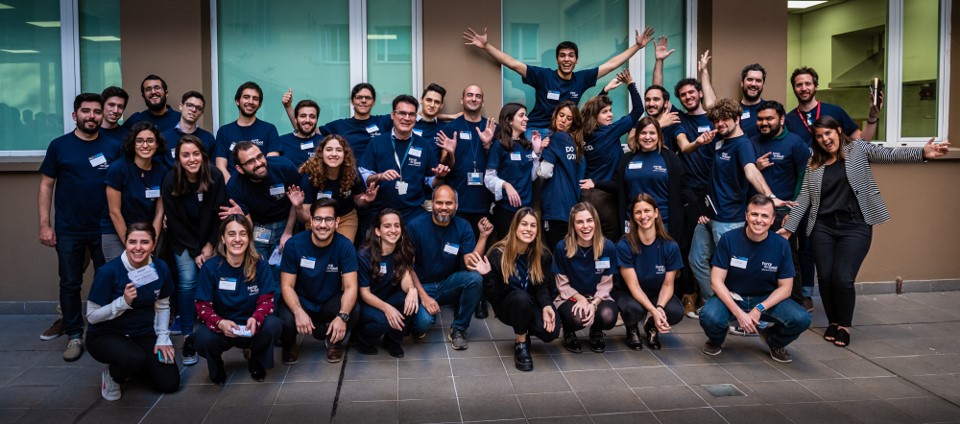JPMorgan Chase & Co’s Tech for Social Good team is celebrating 10 years of doing good. We spoke to four of its leading voices to find out how it has positively impacted thousands of nonprofits, as well as empowering its own workforce.
This is a story that connects sustainable fishing in dangerous seas, phone connectivity in disaster zones, and dogs using iPads to help owners with sight issues. It is a story that brings together a mass volunteering programme and coding hackathons, and a story that is tied together by the collaborative desire to use technology to make the world a better place to live in.
You may be surprised, then, that at the heart of this story is one of the world’s biggest banks. But JPMorgan Chase isn’t your everyday banking institution. In fact, JPMorgan Chase prides itself on being more than just a bank.
It’s no use just talking the talk, though. An organisation has got to walk the walk if it truly wishes to make a positive difference to the communities it serves. And this is where JPMorgan Chase’s Tech For Social Good programme comes in.
We began to change the dialogue about how to engage employees in skilled-based volunteerism
Ten years ago, Ali Marano made a decision that would change her life. She was working for an organisation that provided technology assistance to nonprofits in the social good sector. The recession made the work tough: getting large corporations to provide funding to help her organisation deliver needed tech assistance became increasingly difficult, so Marano changed tack. Rather than asking for financial support, she started pairing skilled volunteers from her corporate funders with nonprofits in need of technology assistance.
“We helped the nonprofits frame what their challenges were, we helped the skilled volunteers articulate what they were able to offer, and this allowed all parties to have a productive relationship leading to impactful solutions,” says Marano.
One of her biggest clients was JPMorgan Chase, and Marano had an epiphany: “What if I did this from the other side?”
“One day I sent a message off to one of the senior leaders at JPMorgan Chase in technology,” says Marano. “And said ‘I can help you rethink the way your staff volunteer their tech skills to nonprofits and this can have a tremendous positive impact not only in the communities where you live and work, but amongst your staff as well’.”
To Marano’s surprise, the exec responded by saying, ‘Ok let’s meet to discuss’. And the rest, as they say, is history.
“Ten years ago we began to change the dialogue about how to engage employees in skilled-based volunteerism to ensure meaningful results on both sides of the equation,” says Marano. “For JPMorgan Chase this work has always been about lifting up social Good organisations and their ability to serve their constituents.”
Efforts at JPMorgan Chase to engage their tech workforce in the social sector began slowly. But 2021 is the 10th anniversary of Tech For Social Good, which Marano is head of, and it has grown beyond anything anyone ever thought it would. It now helps hundreds of organisations every year, providing them with tech expertise and the opportunity to scale.
Tech For Social Good’s stated mission is to lift up communities around the world through the power of people and technology. This is how it works: Through skilled volunteerism, it uses JPMorgan Chase staff to work with students and nonprofits to meet their needs around technology. It does this through several programmes, including: Code for Good, a hackathon which brings employees and external candidates together to ideate on how tech can solve a problem a nonprofit is facing; Force for Good, which connects employees with nonprofits to build sustainable tech solutions; and Youth Programmes, which address the tech skills gap through education and mentorships for people under 18.

The reason for Tech For Social Good is two-pronged: some of those bright candidates that JPMorgan Chase meets through Code for Good will end up being employed by the company, which means it can attract ready-made talent already familiar with them, while it also helps hundreds of social good nonprofits make the world a better place to live in. It’s a win-win.
“Tech For Social Good was developed to bridge the gap between the access to technology resources in the corporate sector, and the lack thereof of that same access to technology in the nonprofit sector,” says Madeline Hutchinson, Tech for Social Good Global Manager.
“The corporate world has really embraced digital transformation, and nonprofits are trying to go on that journey, as well. And I think as corporations, we have a responsibility to help nonprofits move along that journey and get access to technology that will help them scale their mission. And that’s really what Tech For Social Good was started as. We harness the power of technology and our employees and their passion for wanting to make an impact by using their skills to ultimately better uplift the communities where we work and operate.”
Tech For Social Good formalises its goals as ‘Innovate for the social sector’, ‘Build the workforce of the future’, and ‘Develop skills through social good’. Innovation is at the centre of it all, says Marano: “Everything doesn’t have to be done as it always was done. And it’s funny to say that from a company that’s over 200 years old, and has a deep, deep tradition, but the ability to innovate and think about how we can find talent in new ways as well is critical.
“Innovation can be defined in many different ways, and it’s not just about what a corporation might think about at an enterprise level, but innovation truly means your ability to serve your constituents in a greater and more impactful way. It’s enabled because of the work that we do with them. We start conversations not by saying, ‘What’s wrong with your technology and how do I fix it?’ We start conversations by saying, ‘Help me understand your mission and what you’re trying to do to serve your clients and I will talk to you about how innovative uses of technology can further that mission’.”
Let’s return to Tech For Social Good’s programmes; the heartbeat of its operation.
It starts young, with Youth Programmes attracting school-age children to think about technology. It gives JPMorgan Chase the opportunity to encourage and influence the next generation of technologists, and to help inspire schoolchildren about how technology can make a difference to the world. One of the youth events it runs is Generation Tech, where school-age students are invited into JPMorgan Chase offices to take on design challenges for social good organisations. They work in teams, with their goals aligned with United Nations’ sustainability goals.
Code for Good is for any external candidates looking for employment at JPMorgan Chase, and provides the company with a really meaningful way of recruiting talent. Again, they work in teams on challenges posed by charities, building out solutions to the problems. The events tend to involve four or five challenges being taken on by around 150 students – although that expands to over 600 when done remotely due to COVID-19 restrictions. The students produce proof-of-concept ideas and demonstrate how challenges can be overcome through the application of technology, and these ideas are carried through for the organisations. This is where Force for Good comes in.
Force for Good is for JPMorgan Chase employees. They work together in teams, usually over a multi-month period, to build out the solutions for the organisations. JPMorgan Chase steps back only when it is confident that the ideas can be adopted and utilised fully by the organisations, ensuring the process is sustainable for them.


“In our Youth programmes we start by working with youth who come from groups that are often under-represented in professional tech roles,” says Ed Boden, Tech For Social Good global lead. “Then we focus on inspiring and encouraging them to become technologists. Code for Good is a great opportunity to showcase us as an employer of choice, hoping that they might attend and join us. Not every candidate that comes does join us, but a number of them come back and do internships with us, and a number of those then subsequently join our company as a full-time employee.
“Once they join JPMorgan Chase, then they get the opportunity to work on the Force for Good projects. That is a great opportunity to feel they can give back in a very meaningful way to help the social sector. In many cases they get to choose the nonprofits they work with, so they can choose the mission that best aligns with their own personal choices.”
The organisations JPMorgan Chase works with are many and varied. Marano admits that when Tech For Social Good first started it was a tough proposition to sell to nonprofits: a well-known bank coming in and helping them improve the technical side of their operation seemed surprising: “Organisations expected us to help them with their finances, not technology,” says Marano.
Over time, Tech for Social Good has helped add to JPMorgan Chase’s reputation as a strong technology organisation that is also a bank. Now it can ensure that organisations selected to receive its services will be those it feels will most benefit and be able to translate that impact to better serve its communities and constituents.
“When I think about some of the projects I’m most excited about, there are so many to pull from,” says Marano. “One example is work we did with an organisation where we helped local, sustainable fishermen who would go out to sea and didn’t have high-end fleets or boats, which was a real challenge when going out in dangerous weather. So we helped them create a beacon technology that worked on their phones, which would send out a beacon if they were going to be lost at sea or were approaching a storm.”
Marano is also fond of an iPad application that assistive dogs can use in medical situations. Yep, that’s right: an iPad app that a dog can use. If the dog’s owner has a medical emergency, such as falling, it is trained to use its paw prints to send a message that its handler needs immediate help.
“One great one we worked with was an organisation based in the UK that focuses on disaster relief,” says Scott Malinowski, Head of Technology for Tech for Social Good. “And when there’s a natural disaster, they send volunteers and folks on the ground to help them distribute supplies, and really help the area that’s affected. They really need technology to do so.
“One of the big challenges in that scenario is there may not be cell phone connectivity. So we worked with that organisation to set up tools that they could use from their phones to help prioritise need, to help understand what inventory is available and distribute items on the ground to support people in those areas.
“What was really timely about that was we were focused last year on working with that organisation, when COVID started to spread, and they were able to pivot their mission to focus not just on international disaster relief, but domestically in the UK to provide supplies for people in need, who were struggling to get certain things, whether it be medicines or household items locally in the UK.”
A collaborative effort

Madeline Hutchinson, Tech for Social Good Global Manager, talks us through JPMorgan Chase’s Tech For Good symposium, which brings together some of tech’s biggest players to find common goals and ways to collaborate.
“Our goal for starting the Tech For Good symposium was an opportunity for us to really think about how we could collaborate across the industry to move the needle in terms of nonprofit technology.
“I think, for us, social good has always been in our DNA. The symposium gives us the opportunity to recognise that we aren’t the only player in this space; there are a lot of organisations doing great things. And we wanted to amplify our impact by working together with these organisations, and that’s a really important focus for us in the symposium.
“On an industry-wide level, a lot of organisations are pivoting to have social impact or tech for good programming within their cultures and we’ve found that now, more than ever, employees want to give back and use their skills for good. And we as organisations and corporations have a duty to be able to help uplift those communities where we work and operate.
“We want to find ways to connect technologies that some of our symposium members are building so that we can go deeper into providing a holistic solution to the nonprofit partners. I think in order to be successful at that, we really need to bring the nonprofits on board and think about how we can build with them, not for them. I think if we can do that, we will be able to scale the impact of tech for good globally and hopefully be able to solve some of the most pressing issues that face our world today.”
Malinowski heads up a tech team that takes both the skilled volunteers and nonprofits through the entire collaborative process. It trains and advises its staff and the nonprofits’ staff, and reviews all tech decisions to ensure the technology that is being built is both impactful and sustainable for the organisations.
The team monitors all data on each project to ensure they’re on track, provides infrastructure and tools for volunteers to build the technology, and manage risk and security for the nonprofits, as well as JPMorgan Chase’s staff.
It’s this level of detail and care, from start to finish, that has meant Tech For Social Good has been able to grow each year, and why social good organisations continue to turn to it for help. There is one big question, though, that needs answering: how on earth does the team at Tech For Social Good convince so many of JPMorgan Chase’s staff to volunteer?
“I don’t actually think about what we do as a volunteer programme, I think about it as social good initiatives,” says Marano. “And it allows us to really show that we don’t just talk the talk, we walk the walk. So when we say we care about the communities we live and work in, we show it. We don’t just show it by giving dollars which might be expected, we show it by engaging, we show it by giving up our skills, our time, and we do it in thoughtful ways.”
Not everyone is expected to volunteer – far from it. Tech For Social Good wants people to volunteer, not be “voluntold”. Those who do put their hands up – and there are thousands of them – do all of their volunteering within their work hours. Nothing is expected during out-of-office hours.
“Our role is about empowering our staff to be able to give back,” says Boden. “Giving them the opportunity to do more than just pick up a pay cheque every month. For many of our staff it’s vitally important to them that they can give back to all different sorts of organisations, be it working with charities, or be it working with school children.”
With 2021 being the 10th birthday of Tech For Social Good, it begs the obvious question: what will the 20th anniversary look like? Marano is keen to stress that nothing too bold needs to happen: what they’re doing is working. But data is becoming increasingly important. After a decade of Tech For Social Good, the team has a wealth of data that it plans to put back out to the communities in order to ensure social good organisations aren’t starting from scratch each time.
If a homeless charity, for example, comes to JPMorgan Chase looking for help solving a specific problem, Tech For Social Good can immediately share examples of other homeless charities it has worked with on similar issues. The goal is to create a self-help environment in which nonprofits and social good organisations can help and learn from each other to reduce the reliance on JPMorgan Chase.
There has also been an increasing realisation that the skills gap doesn’t exist only in coding. So Tech For Social Good has expanded its focus to take in data science and cyber safety, allowing its staff to give back in broader ways.
“I think in the next 10 years we’ll be looking at opportunities to support project models beyond just building technology solutions,” says Malinowski. “So in our 50,000-employee tech workforce, we have skillsets beyond just software engineers. We have project managers, we have people who handle change management, we have data scientists; a huge number of skillsets throughout the company. And when we talk to a lot of organisations, they have needs beyond just delivering a piece of technology.”
“We’re recognising that tech doesn’t happen in a vacuum and we need so many other skillsets and disciplines to truly make the impact that I would expect over the coming years,” says Marano. “We will have evolved and expanded our remit beyond technology.
“We don’t look at Tech for Social Good as a competitive advantage, we look at it as the right thing to do, we do it because we can and because we have needed skills that can better the communities where we live and work. We love it when peer companies across the world reach out to learn how to do similar work.
“The more focus we all place on leveraging tech in service of social good, the faster we can help address the issues the world is facing today.”




